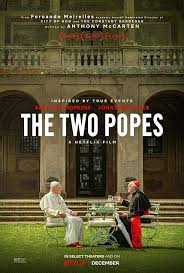A Movie to Make You Think: The Two Popes
The great Yale church historian Jaroslav Pelikan once called the Roman Catholic Church ʺthe most formidable religious institution in the history of America and of the world.ʺ1 One distinguishing doctrinal feature of Catholicism is the claim that the pope is the official leader of Christendom. Of the three branches of Christendom (Orthodoxy, Catholicism, Protestantism), Catholics uniquely view the pope as sitting in the Chair of St. Peter, and thus as the Vicar (or substitute) of Christ himself on Earth.
Since 2013 the Catholic Church has had two living popes—a situation that has not occurred since the Middle Ages (1415). Benedict XVI (born Joseph Ratzinger in 1927) retired unexpectedly in 2013 and now is known as pope emeritus. Pope Francis (born Jorge Bergoglio in 1936) succeeded Benedict and has served as Catholic pontiff for the last seven years. Interestingly, both popes grew up under military dictatorships in their homelands (Ratzinger in Germany and Bergoglio in Argentina).

This very rare occurrence of having two living persons who have carried the prestigious title of Bishop of Rome has made for an engaging new film entitled The Two Popes (2019). The film’s screenwriter Anthony McCarten and director Fernando Meirelles (both self-admitted nominal Catholics) have created a captivating and imaginative story of these two extraordinary ecclesiastical figures in dialogue with one another. Splicing together factual and historical information about the two persons, the movie portrays an imagined meeting and relationship between the two prominent churchmen during Benedict’s papacy. The result is a gripping and believable biographical drama. The elderly German Pope Benedict is played by Anthony Hopkins and the role of the younger Argentinian bishop who will become Pope Francis is performed by Jonathan Pryce.
Two Historic Figures: Catholic Conservative versus Catholic Progressive?
Before he became Pope Benedict XVI, Joseph Ratzinger was recognized as one of the most important conservative Catholic theologians and church leaders of the twentieth century (he is a specialist on the theology of St. Augustine). A close confidant of legendary Pope John Paul II, Bishop Ratzinger served as both prefect of the Congregation for the Doctrine of the Faith and as dean of the College of Cardinals. He has been an ardent defender and, one might say, enforcer, of traditional Catholic doctrine and values.
Pope Francis is in some respects a pontiff of firsts. As an Argentinian, he is the first non-European pope in over a thousand years and the first from the Americas. He is also the first member of the Society of Jesus (Jesuits) to be elected pope. While holding the line on most traditional Catholic doctrines and values, Francis is viewed as being a reformer and somewhat progressive on the application of certain Catholic values, and equally progressive on particular political issues (climate change and the rights of migrants are good examples).
Fictional Dialogue #1: Sparring & Jousting
The heart of the movie focuses on a meeting between the two leaders held in Pope Benedict’s summer residence outside of Rome. When they come together for the first time there is a lot of sparring. The banter reflects a conservative-progressive jousting match. Here are some choice topics and quotes from the exchange:
When Pope Benedict interrogates Cardinal Bergoglio concerning some of his statements about doctrine, Bergoglio insists that his words are often “misquoted” or “taken out of context.”
Pope Benedict responds: “Might I suggest you try telling the newspapers the opposite of what you think—your chances of being quoted correctly might improve.”
When Benedict complains about Bergoglio giving communion to the divorced, Bergoglio shoots back: “I believe that giving communion is not a reward for the virtuous; it is food for the starving!”
Benedict retorts: “So what matters is what you believe but not what the church has taught for hundreds of years.”
When it comes to the discussion of whether the Catholic church should stay the same or change, we get this interchange:
Benedict: “God does not change.”
Bergoglio: “Yes he does. He moves toward us.”
In their tête-à-tête the men discuss other controversial topics such as the priest sex scandal, the church’s decline in numbers, and priest celibacy.
Fictional Dialogue #2: Empathizing & Sharing
After the heated exchange above, the two meet again in the evening and find themselves empathizing with one another as friends and brothers in the Catholic faith.
Benedict: “The hardest thing is to listen. To hear his voice. God’s voice.”
Bergoglio: “Sorry. Even for a pope?”
Benedict: “Perhaps especially for a pope.”
In a lighter moment, while Benedict plays the piano the men exchange amusing quips about the Beatles.
Assessing the Movie
The acting is excellent. Hopkins is a master at delivering lines and Pryce seems to have gotten into the very persona of Bergoglio (again, now Pope Francis). Hopkins captures Benedict’s seriousness about truth, while Pryce reflects Bergoglio’s natural humility and concern for the poor. Visually, the scenes from the Vatican are quite stunning.
This film realistically reflects the way thoughtful people honestly interact about the big topics of religion and politics. It also shows how people who strongly disagree with one another can somehow learn to empathize with each another and find important common ground. This seems a prudent lesson for our fractious time.
The Two Popes is currently streaming on Netflix and Amazon Prime. I highly recommend it. It is genuinely a movie to make you think.
Reflections: Your Turn
Catholic or not, do you have a favorite pope? Visit Reflections on WordPress to comment with your response.
Check out more from Reasons to Believe @Reasons.org
Endnotes
- Jaroslav Pelikan, The Riddle of Roman Catholicism (New York: Abingdon Press, 1960), 12.





